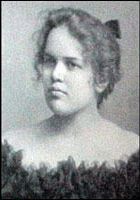Adelaide Crapsey
Adelaide Crapsey Poems
Sun and wind and beat of sea,
Great lands stretching endlessly…
Where be bonds to bind the free?
...
Peter stands by the gate,
And Michael by the throne.
'Peter, I would pass the gate
And come before the throne.'
...
The rose new-opening saith,
And the dew of the morning saith,
(Fallen leaves and vanished dew)
...
In the cold I will rise, I will bathe
In waters of ice; myself
Will shiver, and shrive myself,
Alone in the dawn, and anoint
...
Listen . . .
With faint dry sound,
Like steps of passing ghosts,
The leaves, frost-crisp’d, break from the trees
...
In your
Curled petals what ghosts
Of blue headlands and seas,
What perfumed immortal breath sighing
...
Oh me,
Was there a time
When Paradise knew Eve
In this sweet guise, so placid and
...
The shadowy boy of night
Crosses the dusking land;
He sows his poppy-seeds
With steady, gentle hand.
...
As I went, as I went
Over the mountains,
I heard, I heard,
Through cloud-wreath and mist,
...
Keep thou
Thy tearless watch
All night but when blue-dawn
Breathes on the silver moon, then weep!
...
Fugitive, wistful,
Pausing at edge of her going,
Autumn, the maiden, turns,
Leans to the earth with ineffable
...
The poet pursues his beautiful theme;
The preacher his golden beatitude;
And I run after a vanishing dream—
...
Madonna, Madonnina
Sat by the grey road-side,
Saint Joseph her beside,
And Our Lord at her breast;
...
The morning is new and the skies are fresh washed with light,
The day cometh in with the sun and I awake laughing.
...
Little my lacking fortunes show
For this to eat and that to wear;
Yet laughing, Soul, and gaily go!
An obol pays the Stygian fare.
...
I make my shroud, but no one knows --
So shimmering fine it is and fair,
With stitches set in even rows,
I make my shroud, but no one knows.
...
Adelaide Crapsey Biography
Adelaide Crapsey (September 9, 1878 – October 8, 1914) was an American poet. Born in Brooklyn, New York, she was raised in Rochester, New York, daughter of Episcopal priest Algernon Sidney Crapsey, who had been transferred from New York City to Rochester, and Adelaide T. Crapsey. She attended public school in Rochester, and then Kemper Hall, an Episcopal girls' preparatory school in Kenosha, Wisconsin, before entering Vassar College in Poughkeepsie, New York, where she was class poet for three years and editor-in-chief of the Vassarion in 1901, the year she graduated. That same year her sister Emily died, and Adelaide delayed starting her teaching career for a year. In 1902 she took a position at Kemper Hall, where she taught until 1904. She then spent a year at the School of Classical Studies at the American Academy in Rome and taught for two years at Smith College in Northhampton, Massachusetts. Crapsey was in poor health starting in 1908, following her eldest brother's death in May 1907, and her father's trial for heresy in 1906, after which he was dismissed from the ministry. In 1911, she was diagnosed with tuberculosis, but she withheld the news from her family and continued to teach at Smith until she collapsed in the summer of 1913. She then moved to a private cure cottage in Saranac Lake, New York, where she stayed for a year. In August, 1914, Crapsey returned to Rochester, where she died on October 8, 1914, at the age of 36. In the years before her death, she wrote much of the verse on which her reputation rests. Her interest in rhythm and meter led her to create a variation on the cinquain (or quintain), a 5-line form of 22 syllables influenced by the Japanese haiku and tanka. Her cinquain has a generally iambic meter and consists of 2 syllables in the first and last lines and 4, 6 and 8 syllables in the middle three lines, as shown in the poem Niagara. Adelaide Crapsey also formulated the established epigram into a new form of couplet, a poem of two rhyming lines of ten syllables with an integral title. An example of this grammatical poem is her 'On Seeing Weather-Beaten Trees'. The year following her death, Claude Bragdon published Verses, a posthumous selection of her cinquains and other verse forms. Revised editions were published in 1922 and 1934 and contain earlier unpublished work. Also published posthumously in 1918 was the unfinished A Study in English Metrics, a work she began during her three-year stay in Europe. She is buried in Mount Hope Cemetery in Rochester, and her papers are at the University of Rochester Library archives. Poet Carl Sandburg was partly responsible for the continued interest in the cinquain and in keeping Crapsey from obscurity through his poem "Adelaide Crapsey".)
The Best Poem Of Adelaide Crapsey
Adventure
Sun and wind and beat of sea,
Great lands stretching endlessly…
Where be bonds to bind the free?
All the world was made for me!

I just read Doom, it is sensational